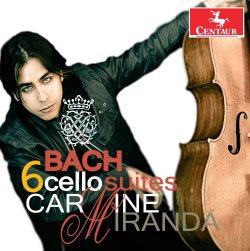| 
|
Johann Sebastian BACH (1685-1750)
Six suites for unaccompanied cello
Suite No. 1, in G major, BMW 1007 [15:49]
Suite No. 2 in D minor, BWV 1008 [17:09]
Suite No. 3 in C major, BWV 1009 [20:08]
Suite No. 4 in E-flat major, BWV 1010 [23:04]
Suite No. 5 in C minor, BWV 1011 [26:14]
Suite No. 6 in D major, BWV 1012 [27:30]
Carmine Miranda (cello)
rec. December 2011 – January 2012, Centaur Records studios, Cincinnati, Ohio.
CENTAUR CRC3263/4 [65:16 + 65:54]
The Six suites for unaccompanied cello by Johann Sebastian Bach were composed some time between 1717 and 1723, when the composer served as Kapellmeister in the placid safety of the court of Prince Leopold of Anhalt-Köthen.
Bach’s devoted wife, Ana Magdalena titled them in a curious brand of Italian, Suites á Violoncello Solo senza Basso. All six of the suites are similarly structured in six movements each: prelude, allemande, courante, sarabande, two minuets or two bourrées or two gavottes, and a final gigue.
The Six suites for unaccompanied cello were not widely known before Pablo Casals recorded them in 1939. One could hazard a guess as to why: the technical demands are enormous. These include prim-chording (same note simultaneously played on two strings), the abundant use of arpeggiated chords, large extensions of the left hand to reach enormous shifting chords, string crossings at every turn, tempi that call for mercurial agility and original scordatura tunings that must be adjusted to standard modern tunings. Above all, there’s the agility demanded of a modern cello by pieces conceived over two hundred years ago for the nimbler five-stringed cello piccolo, with its much higher range, or for the odd-looking violoncello da spalla, which is played like a viola on the player’s shoulder.
The surmounting of technical demands, however, is not what the listener expects from the performer of these works, but qualities often missing from much of the accuracy-driven playing of many of today’s cellists: musicality, passion, and insightfulness. These assets are much in evidence in the playing of Venezuelan-born Carmine Miranda.
The young cellist sails into the deceptively quiet waters of the G major Suite that opens CD 1, with the aplomb of a much older musician, soon making the listener forget that this is the first-time-out for a new-on-the-scene gifted cellist. Here is a musician of not merely great promise, but of immense musicality and a temperament tempered by a total command of the complexity of the music he plays. By the time he arrives at the treacherous maelstrom of the Suite No. 4 one realizes that this is a seasoned player, and that the way he plays is all about the music, all about self-effacing immersion in the artistic task at hand.
After repeated hearings, one remains dazzled by Miranda’s musical acumen, by his unerring instinct for phrasing, by his utterly clear articulation, and by his refusal to sacrifice delicacy or gravitas for the sake of showmanship. His playing of the allemande and courante movements is elegant, and his execution of the various gavottes, bourrées and gigues never lets up on the earthy and rhythmic bounce and thrust of these dance-inspired pieces.
Once Miranda settles down into the utter stillness of the sarabande of the Suite No. 5 in C minor, one rests assured as to being in the aural presence of a great musician.
There are other significant recordings of these pieces, which together form a cornerstone of the repertoire for the cello. Casals, Tortelier, Starker and Yo-Yo Ma have all recorded the Bach suites. In my library there’s the 1979 Anner Bylsma two-CD Sony Classical release under the Essential Classics banner, itself part of the sub-label Early Music.
I’ll not part company with Bylsma’s cooler, arguably more sober reading, but will now keep company with the more sprightly, brighter, Italianate Miranda reading. As a point of comparison, Miranda’s reading of the Alemande – the second movement of the C Major Suite No. 3 clocks in at 3:30, while Bylsma’s laid-back, nordic take on the same piece has the fine Dutch cellist taking four and one half minutes to get through what is, in essence, a dance piece.
The quality of Bylsma’s cello is warmer, perhaps smaller, not surprising for a cello made in 1669 by the great Venetian instrument maker Mattio Goffriller. Miranda’s cello, on the other hand was made in 1994 by the notable Chicago-based William Whedbee. His instrument has a more forward, brighter quality: a nice lyric contralto to Bylsma’s baritone.
In addition, the impeccable production and engineering of Centaur Records’ Charles Rudig and the mastering of Charles Peck serve Miranda’s bright sound to perfection. To be fair, 35 years have elapsed since the Bylsma recording and a lot of high tech water has flown under the proverbial bridge. Astonishingly there was no editing: Miranda sat down and played each of the six suites from start to finish. I like that unadulterated kind of recording.
One looks forward to a soon-to-be-released second album by this protean player, a sampler of pieces for the noblest of instruments by the Italian composer Alfredo Piatti, a composer of note, but one sadly under-represented in today’s world of recorded music.
Rafael de Acha
Masterwork Index: Bach
cello suites
 |
 |
|
